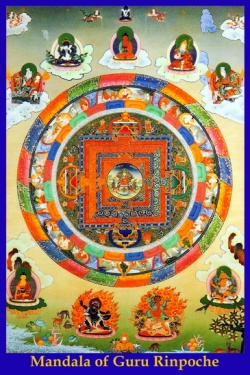Difference between revisions of "Nyingma tantras"
(Created page with "Guru rin.jpg <poem> The Nyingma tradition classifies the corpus of Buddhist teachings into Nine Yanas, among the highest of which is known as Atiyoga o...") |
|||
| (4 intermediate revisions by the same user not shown) | |||
| Line 1: | Line 1: | ||
| − | [[Guru | + | [[File:Guru rin.jpg|thumb|250px|]] |
| + | |||
| + | |||
| + | |||
| + | |||
| + | |||
| + | |||
| + | |||
<poem> | <poem> | ||
The [[Nyingma tradition]] classifies the corpus of [[Buddhist teachings]] into [[Nine Yanas]], among the [[highest]] of which is known as [[Atiyoga]] or [[Dzogchen]] ([[Great Perfection]]). The [[Nine Vehicles]] are: | The [[Nyingma tradition]] classifies the corpus of [[Buddhist teachings]] into [[Nine Yanas]], among the [[highest]] of which is known as [[Atiyoga]] or [[Dzogchen]] ([[Great Perfection]]). The [[Nine Vehicles]] are: | ||
| − | the Three Common Vehicles – | + | |
| + | the [[Three Common Vehicles]] – | ||
| + | |||
(1) [[Shravaka-yana]], [[yana]] of the [[Hearers]], | (1) [[Shravaka-yana]], [[yana]] of the [[Hearers]], | ||
| + | |||
(2) [[Pratyekabuddha-yana]], [[yana]] of the [[Solitary Realizers]], and | (2) [[Pratyekabuddha-yana]], [[yana]] of the [[Solitary Realizers]], and | ||
| − | |||
| − | the | + | (3) the [[Bodhisattva-yana]], the [[Mahayana]] (consisting mainly of the [[sutrayana]] teachings [[taught]] by [[Buddha Shakyamuni]]); |
| + | |||
| + | |||
| + | the [[Three Outer Tantras]] – | ||
| + | |||
(4) [[Kriya Tantra]] [[(Activity) Tantra]], | (4) [[Kriya Tantra]] [[(Activity) Tantra]], | ||
| + | |||
(5) [[Upa Tantra]] [[(Engagement) Tantra]], and | (5) [[Upa Tantra]] [[(Engagement) Tantra]], and | ||
| − | (6) [[Yoga Tantra]] [[(Practice) Tantra]] (the three stages of | + | |
| + | (6) [[Yoga Tantra]] [[(Practice) Tantra]] (the [[three stages of tantra]]); | ||
| + | |||
and the [[Three Innermost Tantras]] – | and the [[Three Innermost Tantras]] – | ||
| + | |||
(7) [[Mahayoga]] (primarily consisting of [[Utpatikrama]] teachings), | (7) [[Mahayoga]] (primarily consisting of [[Utpatikrama]] teachings), | ||
| + | |||
(8) [[Annuyoga]] ({{Wiki|emphasizing}} [[Sampanakrama]]), | (8) [[Annuyoga]] ({{Wiki|emphasizing}} [[Sampanakrama]]), | ||
| + | |||
(9) [[Atiyoga]] (focusing on the most profound [[Sampranakrama]]). | (9) [[Atiyoga]] (focusing on the most profound [[Sampranakrama]]). | ||
| + | |||
| + | |||
The first three are common to all [[schools of Buddhism]] and the next three are common to all schools of [[Tantric Buddhism]], whereas the last three are exclusive to the [[Nyingma tradition]]. | The first three are common to all [[schools of Buddhism]] and the next three are common to all schools of [[Tantric Buddhism]], whereas the last three are exclusive to the [[Nyingma tradition]]. | ||
| + | |||
| + | |||
| + | |||
</poem> | </poem> | ||
{{E}} | {{E}} | ||
[[Category:Nyingma tantric lineages]] | [[Category:Nyingma tantric lineages]] | ||
Latest revision as of 15:13, 16 September 2024
The Nyingma tradition classifies the corpus of Buddhist teachings into Nine Yanas, among the highest of which is known as Atiyoga or Dzogchen (Great Perfection). The Nine Vehicles are:
the Three Common Vehicles –
(1) Shravaka-yana, yana of the Hearers,
(2) Pratyekabuddha-yana, yana of the Solitary Realizers, and
(3) the Bodhisattva-yana, the Mahayana (consisting mainly of the sutrayana teachings taught by Buddha Shakyamuni);
the Three Outer Tantras –
(4) Kriya Tantra (Activity) Tantra,
(5) Upa Tantra (Engagement) Tantra, and
(6) Yoga Tantra (Practice) Tantra (the three stages of tantra);
and the Three Innermost Tantras –
(7) Mahayoga (primarily consisting of Utpatikrama teachings),
(8) Annuyoga (emphasizing Sampanakrama),
(9) Atiyoga (focusing on the most profound Sampranakrama).
The first three are common to all schools of Buddhism and the next three are common to all schools of Tantric Buddhism, whereas the last three are exclusive to the Nyingma tradition.
